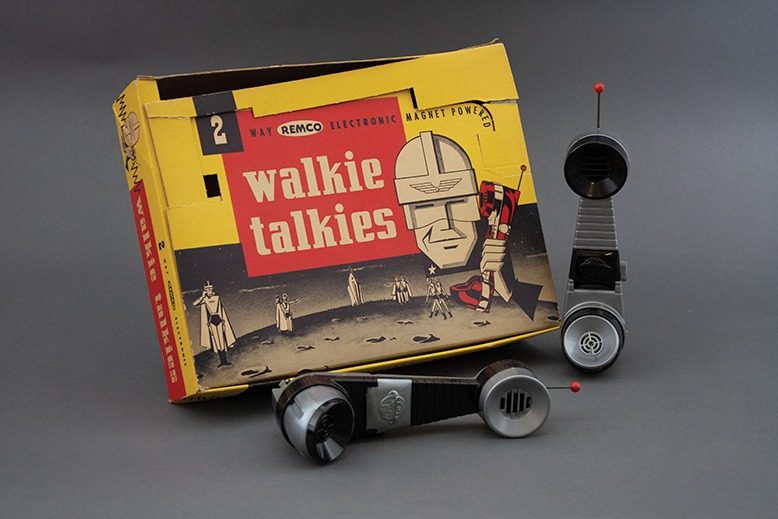
If you have cherished childhood memories of unwrapping that toy you wanted so desperately, or of watching a child or grandchild open a gift box with a new doll or board game inside, there’s good chance the present was invented in New Jersey.
For more than 125 years, since Samuel Leeds Allen invented the Flexible Flyer sled on a Burlington County farm in 1889, New Jersey inventors and toy makers have stoked the imaginations of generations of children, and in the process, produced some of the most iconic toys in American history.
Of course, New Jersey can rightfully claim many more impactful inventions and scientific breakthroughs—after all, we are home to Thomas Edison’s invention studios, Bell Labs, RCA, and many of the world’s leading pharmaceutical companies. Yet it is no exaggeration to say New Jersey has taught the world how to have fun and learn at the same time.

S.L. Allen & Company sleds were invented on a Burlington County farm. Collection of the New Jersey State Museum
Toy train sets, Play-Doh and Colorforms were all invented here. Dick Tracy wristband radios, Raggedy Ann and Andy dolls, Transformers, and those annoying joy buzzers? They, too, have Jersey roots.
“At one time New Jersey was one of the largest toy-manufacturing centers in the nation, and as more toy companies located here, others followed, so the industry created manufacturing and job growth,” says Nicholas Ciotola, curator of cultural history at the New Jersey State Museum, which produced an exhibit on New Jersey toys in 2016.
Many of these toys were created by serious inventors, including Edison, who in 1890 found a way to shrink the phonograph he had invented to fit inside a doll. Hence, the talking doll was created.
Others were conjured by people who found magic in everyday products. Play-Doh, the beloved and squirmy glob of gook, was invented by a Dover nursery-school teacher, Kay Zufall, after a relative initially created the substance as wallpaper cleaner but ran out of customers in the 1950s, when vinyl wallpaper that didn’t require heavy scrubbing was introduced. Since Play-Doh was first marketed as a toy in 1956, more than 3 billion tubs have been sold and it is enshrined in the national Toy Hall of Fame.
Some toys weren’t invented from scratch in New Jersey, but were improved here. Allen wasn’t trying to reinvent the toboggan—he was just trying to find a way to make it safer by installing steering.

Lionel’s electric train sets came to be in Hillside. Collection of the New Jersey State Museum
The first toy train was a steam model, invented in 1889 in Paterson by Eugene Beggs. It was powered by igniting alcohol to make steam—not exactly the safest toy for children. But once electricity became readily available, Lionel introduced the electric train set. At the company’s former factory in Hillside, the workers designed the buildings, homes and other figures used to adorn the sets based on the neighborhoods in and around the Union County town. Today, Lionel’s parts are made overseas but the trains are assembled, painted and decorated in North Carolina.
Ironically, the world’s most popular game, Monopoly, is closely connected to New Jersey, but was not invented here. An Illinois woman created the original game in the early 1890s and called it the Landlord’s Game. Her aim wasn’t to entertain, but to highlight what she saw as the inequities of the capitalist system at the turn of the 20th century.
But a South Jersey Quaker woman named Ruth Hoskins then made her own version of the game, attaching the names of Atlantic City streets to make it more appealing to players in her region. By the time Parker Brothers obtained the rights to the game and began producing it on a large scale in the 1930s, it had come full circle and become the ultimate capitalist game: Bankrupt your competition, monopolize the board, and you win.
The toy industry took hold in New Jersey for many of the same reasons the rest of our economy flourished: proximity to Manhattan, a strategic location in the nation’s transportation network; a skilled labor force; and a diverse industrial base that could provide the materials and products needed to manufacture toys.
“Going back to the 19th century, New Jersey had a major role in toy-making for a long time because of its proximity to New York City, which has always been the center of the toy industry because that’s where the big annual Toy Fair is held,” says Ciotola.
[RELATED: Iconic Candy Brands Born, Bred and Made in New Jersey]
Tin-plate toys with mechanical windups were wildly popular from the 1930s to 1950s and were made in Harrison and later Burlington, as were lead toys. But when plastics became a cheaper and safer alternative to tin and lead in the 1950s, the state’s large chemical industry was able to easily accommodate the needs of its toy makers. As a result, the little green plastic Army men created by the now-defunct Bergen Toy & Novelty Co. of Carlstadt eventually replaced almost all of the metal toys.
Until about 100 years ago, dolls were mostly homemade, imported or produced on a small scale. A pioneer in the mass production of dolls was the Horsman Co. of Trenton, whose manufacturing facility was known as the Doll House, and which once employed 1,200 workers who turned out millions of dolls and stuffed toys. One reason they were able to do this was that New Jersey’s robust embroidery industry was able to supply the hundreds of skilled seamstresses needed to make the dolls’ clothing.
“If you bought a doll between the 1930s and 1960s, it was probably made in New Jersey,” says Ciotola.
In some cases, toys were created to replicate real-life products. The Remco Co. in Newark manufactured walkie-talkies in the early days of the space program and then turned them into plastic replicas that sold millions. “Toy makers are very influenced by their times,” says Ciotola.
During the Cold War of the 1950s and 1960s, when many people suspected there were Communist spies lurking everywhere, the Dick Tracy wristband radio was hugely popular. So, too, were the Johnny 7 toys created by Henry Orenstein, a Holocaust survivor who had escaped the Nazi death camps and later owned Topper Toys, which at its peak employed 5,000 workers at its plant in Elizabeth. His toys featured rapid-firing guns, objects with hidden cameras, and all the other cloak-and-dagger accoutrements a young Cold Warrior could need.
Consciously or not, toys have long served as a means of preparing children for adulthood. “Up until the 1950s and 1960s, it was toy kitchen appliances and babies for girls, and trucks and fighting men and weapons for boys,” says Ciotola. “After that, it was fantasy toys that grew out of the space program.”
[RELATED: 29 Moments That Shaped New Jersey]
There aren’t many toy manufacturers left in New Jersey, but there is a new generation of toy makers looking to capture the zeitgeist. One such company is Modi Toys of Edison, which is focused on the Indian-American market.
“As Indian-Americans, we have a dual identity, and we wanted to find a way to instill in our children appreciation of our culture and beliefs,” says Avani Sakar, who started the business with her brother, Viral Modi. “Our toys are designed after Indian deities that help teach children about who we are and where we’ve come from.”
Modi Toys’ plush dolls include an audio chip inside to explain the background of each deity. Ironically, they are the next generation of the talking doll Edison invented more than 140 years ago.
So what does the future hold for toys in an age of rapidly changing technology? The death of the traditional toy industry has been prophesized more than once, according to toy historian and YouTube host Tim Walsh, who was raised in Voorhees.
“When video games first became popular in the 1980s, many people said traditional toys would disappear, and then along came Trivial Pursuit in 1984, and it sold 20 million copies in the United States in its first year,” says Walsh, who co-created the board game TriBond—which has sold more than 3 million copies—and created the game Blurt!, which has sold more than 1 million copies.
More recently, the invention of the smartphone has cast a long shadow over how children play and learn. Yet “humans will always long for creating their own stories, which is what toys allow them to do,” says Ciotola, adding, “There’s always going to be a desire for us to use our hands and to imagine and create.”
Joseph Lauro is a speechwriter, freelance writer and editor.



